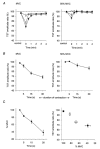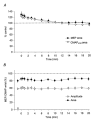Failure of activation of spinal motoneurones after muscle fatigue in healthy subjects studied by transcranial magnetic stimulation
- PMID: 12824449
- PMCID: PMC2343163
- DOI: 10.1113/jphysiol.2003.043562
Failure of activation of spinal motoneurones after muscle fatigue in healthy subjects studied by transcranial magnetic stimulation
Abstract
During a sustained maximal effort a progressive decline in the ability to drive motoneurones (MNs) develops. We used the recently developed triple stimulation technique (TST) to study corticospinal conduction after fatiguing exercise in healthy subjects. This method employs a collision technique to estimate the proportion of motor units activated by a transcranial magnetic stimulus. Following a sustained contraction of the abductor digiti minimi muscle at 50 % maximal force maintained to exhaustion there was an immediate reduction of the TST response from > 95 % to about 60 %. This effect recovered to control levels within 1 min and implies that a decreased number of spinal MNs were excited. Additional TST experiments after maximal and submaximal efforts showed that the decrease in size of the TST response was related to duration and strength of exercise. Motor evoked potentials (MEPs) after conventional transcranial magnetic stimulation (TMS) and responses to peripheral nerve stimulation were recorded following the same fatigue protocol. The size of both the MEPs and the peripheral responses increased after the contraction and were in direct contrast to the decrease in size of the TST response. This points to increased probability of repetitive spinal MN activation during fatigue even if some MNs in the pool failed to discharge. Silent period duration following cortical stimulation lengthened by an average of 55 ms after the contraction and recovered within a time course similar to that of the TST response depression. Overall, the results suggest that the outflow from the motor cortex could become insufficient to drive all spinal MNs to discharge when the muscle is fatigued and that complex interactions between failure of activation and compensatory mechanisms to maintain motor unit activation occur during sustained voluntary activity. When inability to maintain force occurs during submaximal effort, failure of activation of motor units is predominant.
Figures






Similar articles
-
Increased probability of repetitive spinal motoneuron activation by transcranial magnetic stimulation after muscle fatigue in healthy subjects.J Appl Physiol (1985). 2012 Mar;112(5):832-40. doi: 10.1152/japplphysiol.00917.2009. Epub 2011 Dec 15. J Appl Physiol (1985). 2012. PMID: 22174399
-
Remote facilitation of supraspinal motor excitability depends on the level of effort.Eur J Neurosci. 2009 Oct;30(7):1297-305. doi: 10.1111/j.1460-9568.2009.06895.x. Epub 2009 Sep 21. Eur J Neurosci. 2009. PMID: 19769593
-
Effect of stimulus intensity and voluntary contraction on corticospinal potentials following transcranial magnetic stimulation.J Neurol Sci. 1996 Jul;139(1):131-6. J Neurol Sci. 1996. PMID: 8836984
-
Stimulation of the motor cortex and corticospinal tract to assess human muscle fatigue.Neuroscience. 2013 Feb 12;231:384-99. doi: 10.1016/j.neuroscience.2012.10.058. Epub 2012 Nov 3. Neuroscience. 2013. PMID: 23131709 Review.
-
Evidence for a supraspinal contribution to human muscle fatigue.Clin Exp Pharmacol Physiol. 2006 Apr;33(4):400-5. doi: 10.1111/j.1440-1681.2006.04363.x. Clin Exp Pharmacol Physiol. 2006. PMID: 16620309 Review.
Cited by
-
Modulation in voluntary neural drive in relation to muscle soreness.Eur J Appl Physiol. 2008 Mar;102(4):439-46. doi: 10.1007/s00421-007-0604-7. Epub 2007 Nov 3. Eur J Appl Physiol. 2008. PMID: 17978834 Free PMC article.
-
Effects of high resistance muscle training on corticospinal output during motor fatigue assessed by transcranial magnetic stimulation.Front Physiol. 2023 Mar 10;14:1125974. doi: 10.3389/fphys.2023.1125974. eCollection 2023. Front Physiol. 2023. PMID: 36969602 Free PMC article.
-
Low frequency fatigue in human quadriceps is fatigue dependent and not task dependent.J Electromyogr Kinesiol. 2008 Apr;18(2):308-16. doi: 10.1016/j.jelekin.2006.09.010. Epub 2006 Dec 8. J Electromyogr Kinesiol. 2008. PMID: 17157533 Free PMC article.
-
Central and peripheral quadriceps fatigue in congestive heart failure.Int J Cardiol. 2013 Sep 10;167(6):2594-9. doi: 10.1016/j.ijcard.2012.06.064. Epub 2012 Jul 13. Int J Cardiol. 2013. PMID: 22795722 Free PMC article. Clinical Trial.
-
Fatigue-related electromyographic coherence and phase synchronization analysis between antagonistic elbow muscles.Exp Brain Res. 2015 Mar;233(3):971-82. doi: 10.1007/s00221-014-4172-x. Epub 2014 Dec 17. Exp Brain Res. 2015. PMID: 25515087
References
-
- Andersen B, Westlund B, Krarup C. Central conduction failure after muscle fatigue in normal subjects. J Neurol. 2002;249(suppl. 1):71.
-
- Berardelli A, Inghilleri M, Rothwell JC, Cruccu G, Manfredi M. Multiple firing of motoneurones is produced by cortical stimulation but not by direct activation of descending motor tracts. Electroencephalogr Clin Neurophysiol. 1991;81:240–242. - PubMed
-
- Brasil-Neto JP, Pascual-Leone A, Valls-Solé J, Cammarota A, Cohen LG, Hallett M. Postexercise depression of motor evoked potentials: a measure of central nervous system fatigue. Exp Brain Res. 1993;93:181–184. - PubMed
Publication types
MeSH terms
LinkOut - more resources
Full Text Sources
Medical

